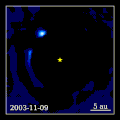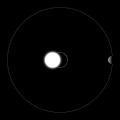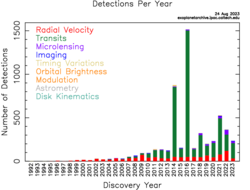Extrasolar planet




An extrasolar planet (or exoplanet) is a natural planet in a planetary system outside our own solar system. A related concept is an exomoon, a natural satellite orbiting an exoplanet.
In 2013, estimates of the number of terrestrial planets in the Milky Way ranged from at least 17 billion[1] to at least 144 billion.[2] The smaller estimate studied planet candidates gathered by the Kepler space observatory.[3] Among them are 461 Earth-size planets, at least four of which are in the "habitable zone" where liquid water can exist. One of the four, dubbed Kepler-69c, is a mere 1.5 times the size of the Earth and around a star like our own Sun – about as near as the current data allow to finding an "Earth 2.0".[4]
Earlier work suggested that there are at least 100 billion planets of all types in our galaxy, an average of at least one per star. There are also planets that orbit brown dwarfs, and free-floating planets that orbit the galaxy directly just as the stars do. It is unclear whether either type should be called a "planet".[5][6][7]
Analogies with planets in the Solar System apply to few of the extrasolar planets known. Most are quite unlike any of our planets, for example the so-called "hot Jupiters".
History
Early speculations
In the sixteenth century, the Italian philosopher Giordano Bruno, an early supporter of the Copernican theory that the Earth and other planets orbit the Sun, put forward the view that the fixed stars are similar to the Sun and are likewise accompanied by planets. Bruno was burnt at the stake by the Holy Inquisition.[8]
In the eighteenth century, the same possibility was mentioned by Isaac Newton in his Principia. Making a comparison to the Sun's planets, he wrote "And if the fixed stars are the centres of similar systems, they will all be constructed according to a similar design and subject to the dominion of One".[9]
Confirmed discoveries
The first published and confirmed discovery was made in 1988.[10] It was finally confirmed in 2002.
In 1992, radio astronomers announced the discovery of planets around a pulsar.[11] These pulsar planets are believed to have formed from the unusual remnants of the supernova that produced the pulsar, in a second round of planet formation. Otherwise they may be the remaining rocky cores of gas giants that survived the supernova and then decayed into their current orbits.
On October 6, 1995, Michel Mayor and Didier Queloz of the University of Geneva announced the first definitive detection of an exoplanet orbiting an ordinary main-sequence star (51 Pegasi).[12] This discovery, made at the Observatoire de Haute-Provence, started the modern era of exoplanetary discovery. Technological advances, most notably in high-resolution spectroscopy, led to the quick detection of many new exoplanets. These advances allowed astronomers to detect exoplanets indirectly by measuring their gravitational influence on the motion of their parent stars. Additional extrasolar planets were eventually detected by watching occultations when a star becomes dimmer as an orbiting planet passed in front of it.
In May 2016 NASA announced the discovery of 1,284 exoplanets which brought the total number of exoplanets to over 3,000.[13]
Types
Extrasolar planets can have many different forms.
- They can be gas giants or rocky planets
- They can possibly be dwarf planets, i.e. planets smaller and less dense than regular planets
- They can orbit several different types of stars
- They can be free-floating or orbit a brown dwarf
- They may support life. One recently discovered exoplanet, Gliese 581g is thought to possibly support life, but the existence of this planet is not yet confirmed.
Classes of exoplanets include:
- A super-terran or super-Earth is a terrestrial planet that is bigger than Earth, but smaller than Neptune
- A water-world is a hypothetical class of planet between terrestrial and jovian. These worlds would have very very little, if any dry land.
- Hot Jupiters are gas planets orbiting closer to their stars than Mercury to the sun.
- Rogue planets orbit no stars at all.
Nearest
The nearest star with planets is Alpha Centauri. It is 4.3 light years away. Using standard rockets, it would take tens of thousands of years to get there.[14] The nearest star similar to our Sun is Tau Ceti. It has five planets, one of which in the habitable zone, where liquid water may exist.[15][16]
Most Earth-like
Some extrasolar planets might be Earth-like. This means that they have conditions very similar to that of the Earth. Planets are ranked by a formula called the Earth similarity index or ESI for short. The ESI goes from one (most Earth-like) to zero (least Earth-like). For a planet to be habitable it should have an ESI of at least 0.8.[17] For comparison, the four solar terrestrial planets are included in this list.
| Name | ESI | SFV | HZD | COM | ATM | Planet type | Star | Habitability | Distance (ly) | Status | Year of discovery |
Ref |
|---|---|---|---|---|---|---|---|---|---|---|---|---|
| Earth | 1.00 | 0.72 | −0.50 | −0.31 | −0.52 | warm terran | G | mesoplanet | 0 | Non-exoplanet, inhabited | prehistoric | |
| Kepler-438b | 0.88 | 0.88 | −0.93 | −0.14 | −0.73 | warm terran | M | mesoplanet | 472.9 | confirmed | 2015 | |
| Kepler-1410b | 0.88 | 0.63 | −0.88 | −0.16 | −0.06 | warm superterran | K | mesoplanet | 1213.4 | confirmed | 2011 | [18] |
| Gliese 667 Cc | 0.84 | 0.64 | −0.62 | −0.15 | +0.21 | warm terran | M | mesoplanet | 23.6 | confirmed | 2011 | [19] |
| Kepler-442b | 0.83 | 0.98 | −0.72 | −0.15 | +0.28 | warm superterran | K | mesoplanet | 1291.6 | confirmed | 2015 | |
| Kepler-62e | 0.83 | 0.96 | −0.70 | −0.15 | +0.28 | warm superterran | K | mesoplanet | 1199.7 | confirmed | 2013 | |
| Kepler-452b | 0.83 | 0.93 | −0.61 | -0.15 | -0.30 | warm superterran | G | mesoplanet | 1402.5 | confirmed | 2015 | [20][21][22] |
| Gliese 832 c | 0.81 | 0.96 | −0.72 | −0.15 | +0.43 | warm superterran | M | mesoplanet | 16.1 | confirmed | 2014 | |
| Kepler-283c | 0.79 | 0.85 | −0.58 | −0.14 | +0.69 | warm superterran | K | mesoplanet | 1496.8 | confirmed | 2011 | |
| Kepler-436b | 0.79 | 0.33 | −0.87 | −0.14 | +0.47 | warm superterran | M | mesoplanet | 1339.4 | confirmed | 2015 | |
| Kepler-1229b | 0.79 | 0.00 | −0.40 | −0.15 | +0.44 | warm superterran | M | mesoplanet | 769.7 | confirmed | 2016 | |
| Tau Ceti e | 0.78 | 0.00 | −0.92 | −0.15 | +0.16 | warm superterran | G | mesoplanet | 11.9 | unconfirmed | 2012 | |
| Kepler-296f | 0.78 | 0.15 | −0.90 | −0.14 | +0.53 | warm superterran | M | mesoplanet | 1089.6 | confirmed | 2011 | |
| Gliese 180 c | 0.77 | 0.42 | −0.53 | −0.14 | +0.64 | warm superterran | M | mesoplanet | 39.5 | unconfirmed | 2014 | |
| Gliese 667 Cf | 0.77 | 0.00 | -0.22 | −0.16 | +0.08 | warm terran | M | psychroplanet | 23.6 | dubious | 2013 | |
| Gliese 581 g | 0.76 | 1.00 | -0.70 | −0.15 | +0.28 | warm superterran | M | mesoplanet | 20.2 | dubious | 2010 | |
| Gliese 163 c | 0.75 | 0.02 | −0.96 | −0.14 | +0.58 | warm superterran | M | mesoplanet | 48.9 | confirmed | 2012 | |
| Gliese 180 b | 0.75 | 0.41 | −0.88 | −0.14 | +0.74 | warm superterran | M | mesoplanet | 39.5 | unconfirmed | 2014 | |
| HD 40307 g | 0.74 | 0.04 | −0.23 | −0.14 | +0.77 | warm superterran | K | psychroplanet | 41.7 | confirmed | 2012 | |
| Kepler-61b | 0.73 | 0.27 | −0.88 | −0.13 | +1.24 | warm superterran | M | mesoplanet | 1062.8 | confirmed | 2013 | |
| Kepler-443b | 0.73 | 0.91 | −0.49 | −0.13 | +1.44 | warm superterran | K | mesoplanet | 2564.4 | confirmed | 2015 | |
| Gliese 422 b | 0.71 | 0.17 | −0.41 | −0.13 | +1.11 | warm megaterran | M | mesoplanet | 41.3 | unconfirmed | 2014 | |
| Kepler-22b | 0.71 | 0.53 | −0.64 | −0.12 | +1.79 | warm superterran | G | mesoplanet | 619.4 | confirmed | 2011 | |
| Kepler-440b | 0.70 | 0.00 | +0.01 | −0.15 | +0.38 | warm superterran | K | psychroplanet | 706.5 | confirmed | 2015 | |
| Kepler-298d | 0.68 | 0.00 | −0.86 | −0.11 | +2.11 | warm superterran | K | mesoplanet | 1545 | confirmed | 2012 | [23] |
| Kepler-439b | 0.68 | 0.00 | −0.99 | −0.13 | +1.18 | warm superterran | G | thermoplanet | 1914.8 | confirmed | 2015 | |
| Kapteyn b | 0.67 | 0.00 | +0.08 | −0.15 | +0.57 | warm superterran | M | psychroplanet | 12.7 | unconfirmed | 2014 | |
| Kepler-62f | 0.67 | 0.05 | +0.45 | −0.16 | +0.19 | warm superterran | K | psychroplanet | 1199.7 | confirmed | 2013 | |
| Kepler-186f | 0.64 | 0.00 | +0.48 | −0.17 | −0.26 | warm terran | M | psychroplanet | 492 | confirmed | 2014 | |
| Kepler-174d | 0.61 | 0.00 | +0.32 | −0.13 | +1.77 | warm superterran | K | psychroplanet | 878.3 | confirmed | 2011 | |
| Gliese 667 Ce | 0.60 | 0.00 | +0.51 | −0.16 | +0.23 | warm terran | M | psychroplanet | 23.6 | dubious | 2013 | |
| Gliese 682 c | 0.59 | 0.00 | +0.22 | −0.14 | +1.19 | warm superterran | M | psychroplanet | 16.6 | unconfirmed | 2014 | |
| Gliese 581 d | 0.53 | 0.00 | +0.78 | −0.14 | +0.94 | warm superterran | M | hypopsychroplanet | 20.2 | unconfirmed | 2007 | [24][25] |
| Kepler-155c | hot superterran | K | hyperthermoplanet? | 965 | confirmed | 2014 | ||||||
| Venus | 0.78 | 0.00 | −0.93 | −0.28 | −0.70 | warm terran | G | hyperthermoplanet | close to zero | non-exoplanet | prehistoric | |
| Mars | 0.64 | 0.00 | +0.33 | −0.13 | −1.12 | warm subterran | G | hypopsychroplanet | close to zero | non-exoplanet | prehistoric | |
| Mercury | 0.39 | 0.00 | −1.46 | −0.52 | −1.37 | hot mercurian | G | non-habitable | close to zero | non-exoplanet | prehistoric |
Extrasolar Planet Media
Four exoplanets of the HR 8799 system imaged by the W. M. Keck Observatory over the course of seven years. Motion is interpolated from annual observations.
Comparison of the size of exoplanets orbiting Kepler-37 to Mercury, Mars and Earth
Exoplanet HIP 65426b is the first discovered planet around star HIP 65426.
Coronagraphic image of AB Pictoris showing a companion (bottom left), which is either a brown dwarf or a massive planet. The data were obtained on 16 March 2003 with NACO on the VLT, using a 1.4 arcsec occulting mask on top of AB Pictoris.
Directly imaged planet Beta Pictoris b, with an edge-on orbit as seen from Earth
Animation showing difference between planet transit timing of one-planet and two-planet systems
Related pages
References
- ↑ Staff (2013). "17 billion Earth-size alien planets inhabit Milky Way". Space.com. Retrieved 8 January 2013.
- ↑ Kopparapu, Ravi kumar (2013). "A revised estimate of the occurrence rate of terrestrial planets in the habitable zones around kepler m-dwarfs". Astrophysical Journal - Letters. 767 (1): L8. arXiv:1303.2649v1. Bibcode:2013ApJ...767L...8K. doi:10.1088/2041-8205/767/1/L8. S2CID 119103101.
- ↑ Palmer, Jason (2013-01-08) (in en-GB). Earth-sized planets 'number 17bn'. BBC News. https://www.bbc.com/news/science-environment-20942440. Retrieved 2019-01-04.
- ↑ Palmer, Jason 2013. Kepler telescope: Earth-sized planets 'number 17bn'. BBC News Science & Environment. [1]
- ↑ Claven, Whitney (2013). "Billions and billions of planets". NASA. Archived from the original on 21 April 2020. Retrieved 3 January 2013.
- ↑ Staff (2013). "100 billion alien planets fill our Milky Way galaxy". Space.com. Retrieved 3 January 2013.
{{cite web}}: CS1 maint: uses authors parameter (link) - ↑ Cassan A; et al. (2012). "One or more bound planets per Milky Way star from microlensing observations". Nature. 481 (7380): 167–169. arXiv:1202.0903. Bibcode:2012Natur.481..167C. doi:10.1038/nature10684. PMID 22237108. S2CID 2614136. Retrieved 2012-01-11.
- ↑ "Cosmos" in The New Encyclopædia Britannica (15th edition, Chicago, 1991) 16:787:2a. "For his advocacy of an infinity of suns and earths, he was burned at the stake in 1600."
- ↑ Brackenridge, J. Bruce; Newton, Isaac (1999) [1713]. The Principia: A New Translation and Guide. University of California Press. p. 940. ISBN 978-0-520-20217-7.
- ↑ Campbell B.; Walker G.A.H.; Yang S. 1988. A search for substellar companions to solar-type stars. Astrophysical Journal 331: 902–921. Bibcode 1988ApJ...331..902C. doi:10.1086/166608
- ↑ Wolszczan A. & Frail D.A. 1992. A planetary system around the millisecond pulsar PSR1257+12. Nature 355 (6356): 145–147. doi:10.1038/355145a0
- ↑ M. Mayor, D. Queloz (1995). "A Jupiter-mass companion to a solar-type star". Nature. 378 (6555): 355–359. Bibcode:1995Natur.378..355M. doi:10.1038/378355a0. S2CID 4339201.
- ↑ "NASA's Kepler Mission Announces Largest Planet Collection Ever Discovered" May 10, 2016 https://www.nasa.gov/press-release/nasas-kepler-mission-announces-largest-collection-of-planets-ever-discovered
- ↑ "Travelling to Alpha Centauri". EarthSky.org. Retrieved 19 April 2013.
- ↑ Tau Ceti's planets nearest around single, Sun-like star. BBC News Science & Environment. [2]
- ↑ Tuomi M. et al [2012]. Signals embedded in the radial velocity noise. Astronomy and Astrophysics (in press). [3]
- ↑ "PHL Habitable planet methods". Archived from the original on 2012-09-11. Retrieved 2015-09-05.
- ↑ "The New Potential Habitable Exoplanets Candidates of NASA Kepler - Planetary Habitability Laboratory @ UPR Arecibo". phl.upr.edu. Archived from the original on 2021-01-20. Retrieved 2019-01-01.
- ↑ "Habitable Exoplanets Catalog". Planetary Habitability Laboratory. 2015. Retrieved 3 June 2015.
- ↑ "NASA's Kepler Mission Discovers Bigger, Older Cousin to Earth". Press release. 23 July 2015. http://www.nasa.gov/press-release/nasa-kepler-mission-discovers-bigger-older-cousin-to-earth. Retrieved 23 July 2015.
- ↑ "News - Astronomers discover Earth's 'bigger, older cousin' - The Weather Network". Archived from the original on 2020-11-24. Retrieved 2015-09-05.
- ↑ "NameBright - Coming Soon". Archived from the original on 2017-07-01. Retrieved 2015-09-05.
- ↑ "Habitable Exoplanets Catalog: Data of Potentially Habitable Worlds". Planetary Habitability Laboratory. 2015. Archived from the original on 1 December 2017. Retrieved 3 June 2015.
- ↑ Reanalysis of data suggests ‘habitable’ planet GJ 581d really could exist – Astronomy Now
- ↑ http://www.sciencemag.org/content/347/6226/1080.3.abstract
Other websites
Search projects
Resources
- NASA's PlanetQuest Archived 2011-02-25 at the Wayback Machine
- PlanetQuest 3D Atlas of extrasolar planets within 400 light years of our Solar System Archived 2006-09-29 at the Wayback Machine
- Planetquest Flash Archived 2006-10-01 at the Wayback Machine
- German Center for Exo-Planet Research Jena/Tautenburg
- Astrophysical Institute & University Observatory Jena (AIU)
- Table of known planetary systems
- Extrasolar Planet XML Database Archived 2006-10-04 at the Wayback Machine
- Andrew Collier Cameron, Extrasolar planets, Physics World (January 2001). (See the online version Archived 2004-08-08 at the Wayback Machine.)
- searchable dynamic database of extrasolar planets and their parent stars Archived 2018-10-01 at the Wayback Machine
- List of important exoplanets
- Extrasolar Planets - D. Montes, UCM
- Extrasolar Visions Archived 2008-05-09 at the Wayback Machine
News
- 6-8 Earth-Mass Planet Discovered orbiting Gliese 876 Archived 2008-12-20 at the Wayback Machine
- Newfound World Shatters Distance Record from space.com
- Oldest Known World from space.com
- Earth Sized Planets Confirmed from space.com
- Sunshade to Look for Distant Life from news.bbc.co.uk









